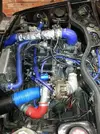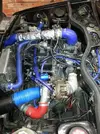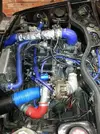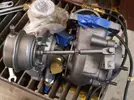DaveL485
Staff member
Problem solved.If it was working before you touched it I'd happily say you've broken it lol!
I'd guess you've got the wires the wrong way round or a bad earth maybe? I'd like to know more about how that system works, not really looked into as I've got bigger issues ATM, let me know how you get on Andy

Problem solved.If it was working before you touched it I'd happily say you've broken it lol!
I'd guess you've got the wires the wrong way round or a bad earth maybe? I'd like to know more about how that system works, not really looked into as I've got bigger issues ATM, let me know how you get on Andy

Personally i'd run the pressure switch mate. There is a switch and a sender. The switch is an 1/0 switch that trips at ~1bar oil pressure. Anything under that sticks the warning lights on and turns the pressure gauge into a level gauge. When oil pressure exceeds 1 bar and trips the pressure switch, it turns off the pressure lights and the oil pressure gauge uses the sender to read variable pressure.
Although you have replaced the sender/pressure gauge, you now have no oil pressure warning lights. When you're spanking it on track, what happens if you lose pressure and don't notice it right away? You simply do not drive at 10/10ths AND watch the gauges closely. It's impossible. Red lights appearing on the dash within your periforal vision will flag immediately if oil pressure drops. Really recommend reconnecting the switch at least.
Problem solved.If it was working before you touched it I'd happily say you've broken it lol!
I'd guess you've got the wires the wrong way round or a bad earth maybe? I'd like to know more about how that system works, not really looked into as I've got bigger issues ATM, let me know how you get on Andy

Personally i'd run the pressure switch mate. There is a switch and a sender. The switch is an 1/0 switch that trips at ~1bar oil pressure. Anything under that sticks the warning lights on and turns the pressure gauge into a level gauge. When oil pressure exceeds 1 bar and trips the pressure switch, it turns off the pressure lights and the oil pressure gauge uses the sender to read variable pressure.
Although you have replaced the sender/pressure gauge, you now have no oil pressure warning lights. When you're spanking it on track, what happens if you lose pressure and don't notice it right away? You simply do not drive at 10/10ths AND watch the gauges closely. It's impossible. Red lights appearing on the dash within your periforal vision will flag immediately if oil pressure drops. Really recommend reconnecting the switch at least.
Thanks Dave, as always, you knowledge is greatly appreciated.
The pressure switch is not simply an on off switch, it can't be as the dash in the 5 gives a variable output no?
What was ingesting was when I was testing things last night, I first bridged out the connections on the oil level sensor to reveal nothing. I then bridged out the pressure switch also, both in running and non running conditions. Are these sensors fused somewhere illogical lol. I would rather have them connected for sure. That part of the loom needs renewing anyway, so I'll have to investigate this before my next track day.
Thanks again.
Stotty.
Thanks Dave, as always, you knowledge is greatly appreciated.
Problem solved.
Cut the wiring out as it serves nothing - I now have a Durite stand alone pressure gauge whicThh shows the pressure and I never took any notice of the oil level indicator - 1 less thing to worry about.

I use a -34 garrett actuator on my setup. You want a minimum of -31 on yours Andy.
The dash number isn't the boost pressure required to compress the spring, per-se, in fact IIRC the -31 is actually part number -0031.
I may be talking shite here but I vaguely recall, if the part numbers are not arbitrary, that the last 2 numbers of the part number (-0031 or -0034) might be the pressure in inches of mercury that the actuator is fully extended.... [-31= 31Hg = 15.2psi], [-34 = 34Hg = 16.7psi]. But as I say, I may have made that up in the vast realms of shite that whirl around my brain.
